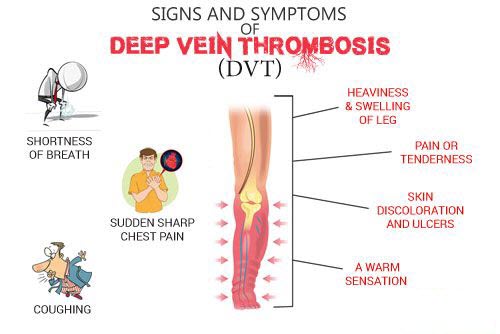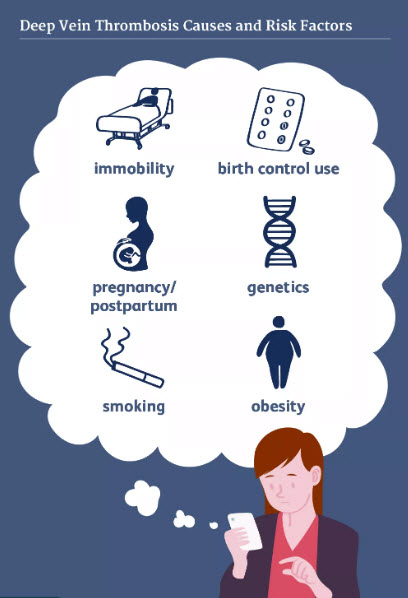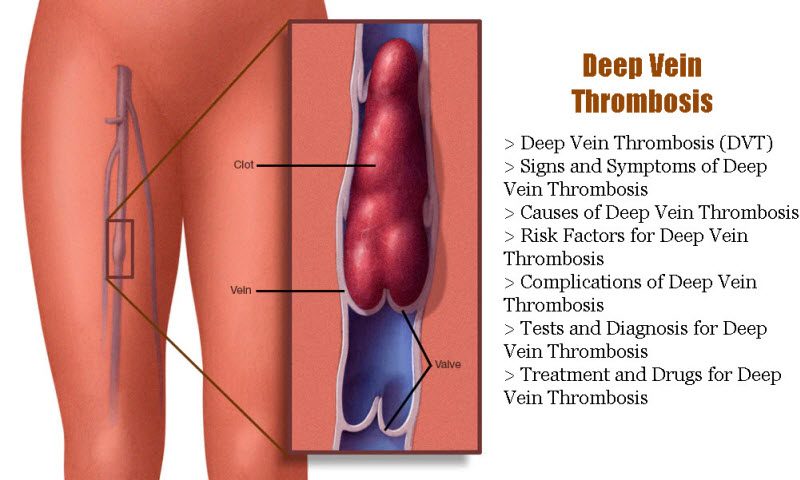This discussion covers the following information related to Deep Vein Thrombosis:
- Deep Vein Thrombosis (DVT)
- Signs and Symptoms of Deep Vein Thrombosis
- Causes of Deep Vein Thrombosis
- Risk Factors for Deep Vein Thrombosis
- Complications of Deep Vein Thrombosis
- Tests and Diagnosis for Deep Vein Thrombosis
- Treatment and Drugs for Deep Vein Thrombosis
Deep Vein Thrombosis Definition

Deep vein thrombosis (DVT) occurs when a blood clot (thrombus) forms in one or more of the deep veins in your body, usually in your legs. Deep vein thrombosis can cause leg pain or swelling, but may occur without any symptoms.
Deep vein thrombosis can develop if you have certain medical conditions that affect how your blood clots. Deep vein thrombosis can also happen if you don’t move for a long time, such as after surgery, following an accident, or when you are confined to a hospital or nursing home bed.
Deep vein thrombosis is a serious condition because blood clots in your veins can break loose, travel through your bloodstream and lodge in your lungs, blocking blood flow (pulmonary embolism).
Signs and Symptoms of Deep Vein Thrombosis

Deep vein thrombosis signs and symptoms can include:
- Swelling in the affected leg. Rarely, there may be swelling in both legs.
- Pain in your leg. The pain often starts in your calf and can feel like cramping or a soreness.
- Deep vein thrombosis may sometimes occur without any noticeable symptoms.
EMERGENCY CASES If you develop signs or symptoms of deep vein thrombosis, contact your doctor for guidance. If you develop signs or symptoms of a pulmonary embolism — a life-threatening complication of deep vein thrombosis — seek medical attention immediately. The warning signs of a pulmonary embolism include:
Causes of Deep Vein Thrombosis
Deep vein thrombosis occurs when a blood clot forms in the veins that are deep in your body, often in your legs. Blood clots can be caused by anything that prevents your blood from circulating normally or clotting properly.
Risk Factors for Deep Vein Thrombosis

Many factors can increase your risk of developing deep vein thrombosis (DVT), and the more you have, the greater your risk. Risk factors for DVT include:
- Inheriting a blood-clotting disorder: Some people inherit a disorder that makes their blood clot more easily. This inherited condition may not cause problems unless combined with one or more other risk factors.
- Prolonged bed rest, such as during a long hospital stay, or paralysis. When your legs remain still for long periods, your calf muscles don’t contract to help blood circulate, which can increase the risk of blood clots.
- Injury or surgery: Injury to your veins or surgery can increase the risk of blood clots.
- Pregnancy: Pregnancy increases the pressure in the veins in your pelvis and legs. Women with an inherited clotting disorder are especially at risk. The risk of blood clots from pregnancy can continue for up to six weeks after you have your baby.
- Birth control pills or hormone replacement therapy: Birth control pills (oral contraceptives) and hormone replacement therapy both can increase your blood’s ability to clot.
- Being overweight or obese: Being overweight increases the pressure in the veins in your pelvis and legs.
- Smoking: Smoking affects blood clotting and circulation, which can increase your risk of DVT.
- Cancer: Some forms of cancer increase the amount of substances in your blood that cause your blood to clot. Some forms of cancer treatment also increase the risk of blood clots.
- Heart failure: People with heart failure have a greater risk of DVT and pulmonary embolism. Because people with heart failure already have limited heart and lung function, the symptoms caused by even a small pulmonary embolism are more noticeable.
- Inflammatory bowel disease: Bowel diseases, such as Crohn’s disease or ulcerative colitis, increase the risk of DVT.
- A personal or family history of deep vein thrombosis or pulmonary embolism (PE): If you or someone in your family has had DVT or PE before, you’re more likely to develop DVT.
- Age: Being over age 60 increases your risk of DVT, though it can occur at any age.
- Sitting for long periods of time, such as when driving or flying. When your legs remain still for many hours, your calf muscles don’t contract, which normally helps blood circulate. Blood clots can form in the calves of your legs if your calf muscles aren’t moving for long periods.



